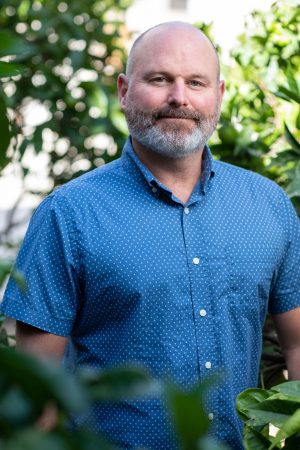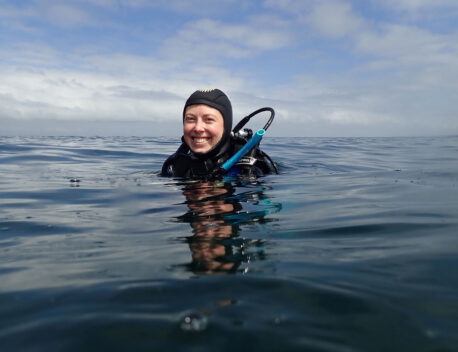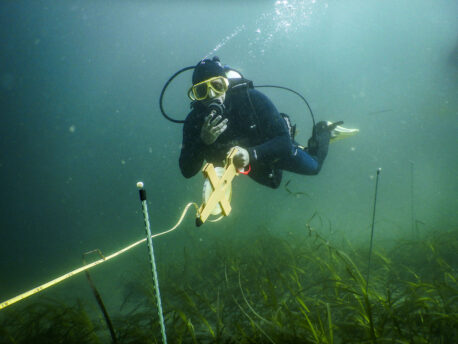
October 29, 2025
Salk and UC San Diego scientists discover a hybrid seagrass that demonstrates low-light tolerance, setting the scene for genomically informed approaches to coastal restoration
Salk and UC San Diego scientists discover a hybrid seagrass that demonstrates low-light tolerance, setting the scene for genomically informed approaches to coastal restoration
LA JOLLA—Seagrasses preserve our oceans, offering safe harbor for sea life, calming rough waters, and storing excess carbon dioxide. Dozens of seagrass species protect coastlines around the globe, including the common North American eelgrass, Zostera marina. But these beneficial underwater meadows are under threat from boating, dredging, disease, and extreme weather. Restoration efforts that simply replant more eelgrasses fail around half the time—so, what now?

Scientists from the Salk Institute and Scripps Institution of Oceanography at UC San Diego say one solution is genomically informed restoration. In the waters of San Diego’s Mission Bay, a new hybrid seagrass has begun to grow. The hybrid is a cross between the shallow-water Zostera marina and its deeper-water cousin, Zostera pacifica, whose tolerance for low-light conditions is a favorable trait as coastal waters become increasingly murky. The researchers used advanced genomic and transcriptomic technologies to investigate the hybrid, finding that the genes that control the internal timing mechanism—called the circadian clock and inherited from Zostera pacifica—may help the hybrid tolerate low light.
The scientists say this genomic profile could make the new hybrid seagrass a candidate for future coastal restoration efforts in California and beyond.
The study was published in Nature Plants on October 29, 2025, and was funded by both federal research funding from the National Science Foundation and private philanthropy focused on developing plants to capture and store more carbon.
“If this hybrid inherits Zostera pacifica’s low-light toolkit, it could become a new avenue for restoration, guiding where and how we plant new seagrasses, and which genes or lineages are most likely to survive in murky waters,” says senior author Todd Michael, PhD, a research professor at Salk. “Further field tests will be needed, but the genetics suggest a promising path to more resilient seagrass meadows.”
What we know about eelgrasses, and why restoration efforts have failed

Eelgrasses cycle nutrients, improve water quality, and prevent coastal erosion, among many other functions. These abundant benefits have made them a prime target for coastal restoration efforts. As such, scientists have spent some time studying their genetics and attempting to replant them on once-covered seafloors. These efforts produced a fully sequenced Zostera marina genome in 2016, as well as decades of restoration efforts for researchers to scour for successes and failures.
One major source of failure was made clear in a 50-year retrospective: Zostera marina cannot survive low-light conditions. Zostera marina has developed mechanisms to endure the predictable, seasonal low light that occurs every winter by eating up emergency sugar stores to survive until spring or entering a period of dormancy. But coastal runoff and dredging in the bays that eelgrasses inhabit have reduced light availability year-round, pushing the seagrass to its stress limits for longer than it is biologically prepared.
“We were searching for the genetic underpinnings of how seagrasses cope with low-light conditions,” says first author Malia Moore, PhD, a former graduate student researcher at Scripps Institution of Oceanography at UC San Diego, where she was co-advised by Michael at Salk. “If there are some genetic individuals that are more resilient, and that’s encoded in their genomes, could we find that? And could we then use those insights to inform restoration efforts that tackle this intolerance to low light?”
Launching a new era of genome-informed plant restoration
When Zostera pacifica and Zostera marina became seafloor neighbors, they hybridized to create a daughter eelgrass. Luckily for the Salk and UC San Diego team, a robust bed of this hybrid grows locally in San Diego’s Mission Bay. Hybrids tend to outperform their parents in extreme environments, such as in the low-light conditions that stress Zostera marina. Hybrids can also serve as critical intermediates that bridge gaps between species, like the shallow-water Zostera marina and deeper-water Zostera pacifica.

The researchers sequenced the hybrid’s genome and compared its transcriptome with Zostera marina to test whether it had inherited Zostera pacifica’s low-light tolerance. While the genome is a straightforward catalog of the many genes in an organism, the transcriptome represents the genes that are actively being used—in this case, those being used in low-light conditions.
The genome helped the researchers confirm that the hybrid was a first-generation cross between Zostera marina and Zostera pacifica. After confirming the cross, the team grew the hybrid and Zostera marina side by side in low-light tanks and compared their transcriptomes to pinpoint differences in light response. This tank setup was dubbed “extreme gardening” by the researchers, as growing these finicky sea plants is a feat of its own, since eelgrasses support each other through complex underground networks of stems and are very particular about their soil.
After successful extreme gardening, transcriptomic analysis revealed that Zostera marina and the hybrid had differing gene expression across light regulation, sugar use, and stress responses. Despite receiving reduced light, the hybrid expressed genes involved in photosynthesis—an effect not observed in Zostera marina. Some of the most prominent divergences were in genes controlling their circadian clocks, such as the central time-keeping gene called LATE ELONGATED HYPOCOTYL (LHY).
The circadian clock in plants does much more than tell the plant when dawn and dusk occur; it also integrates the amount of light the plant has experienced, and controls growth accordingly. The scientists hypothesize that these circadian genes enable Zostera pacifica and the hybrid to collect light for a longer period over the day. In contrast, Zostera marina stops in the morning, which could be the key to more resilient eelgrass beds that endure seasonal storms and algal blooms.
Where the eelgrass hybrid fits in the future of coastal restoration
Hybrid eelgrass growing in Mariner’s Basin in San Diego.
Credit: Emma Toussaint of Scripps Institution of Oceanography
Bringing this hybrid eelgrass into coastal restoration efforts will require follow-up research and collaborations with ecologists, who are experts at mapping out the many ways that introducing a new organism might impact its environment.
“How reproductively viable is the hybrid? Is it attracting different fish and invertebrates? Is it creating as much biomass? There are a ton of questions we still need to answer about how the hybrid might affect the ecosystems that it’s planted in,” explains Moore. “Now, we have a hybrid and natural population to study how restoration may work.”
But the future is bright for restoration efforts. Modern genomic and transcriptomic technology yield insights into how plants are specifically adapted to different ecologies. And, by learning the biological mechanism that explains why one plant survives in a specific location while its neighbor perishes, scientists can embark on genomically informed restoration by developing plants tuned to specific environments so that they can protect coastlines, shelter sea life, clean murky waters, and much more.
“Most studies collapse genomes into a single consensus, but our assembly of the hybrid separates the Zostera marina and Zostera pacifica subgenomes, allowing us to unambiguously track gene expression from the Zostera pacifica subgenome through to the hybrid,” says Michael. “With these genomic resources, we can replace trial-and-error plantings—which fail in up to 60 percent of Zostera projects—with genomically informed restoration, selecting genome-environment-matched plants to markedly improve establishment and long-term success.”
Other authors include Nicholas Allsing, Nolan Hartwick, and Allen Mamerto of Salk; Emily Murray of Scripps Institution of Oceanography and Salk; and Rilee Sanders of Scripps Institution of Oceanography and Paua Marine Research Group.
The work was supported by the Salk Harnessing Plants Initiative through TED Audacious, Bezos Earth Fund, and Hess Corporation; Bill and Melinda Gates Foundation (INV-040541); National Science Foundation (Fellowship #2021321499); and Tang Genomics Fund.
DOI: 10.1038/s41477-025-02142-2
JOURNAL
Nature Plants
AUTHORS
Malia L. Moore, Nicholas Allsing, Nolan T. Hartwick, Allen Mamerto, Emily R. Murray, Rilee D. Sanders, Todd P. Michael
Office of Communications
Tel: (858) 453-4100
press@salk.edu
Unlocking the secrets of life itself is the driving force behind the Salk Institute. Our team of world-class, award-winning scientists pushes the boundaries of knowledge in areas such as neuroscience, cancer research, aging, immunobiology, plant biology, computational biology and more. Founded by Jonas Salk, developer of the first safe and effective polio vaccine, the Institute is an independent, nonprofit research organization and architectural landmark: small by choice, intimate by nature, and fearless in the face of any challenge.